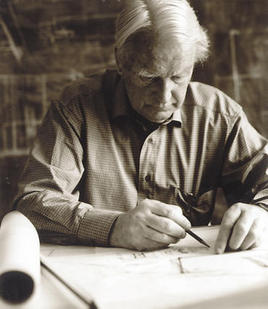Sverre Fehn facts for kids
Quick facts for kids
Sverre Fehn
|
|
|---|---|
 |
|
| Born | 14 August 1924 |
| Died | 23 February 2009 (aged 84) Oslo, Norway
|
| Nationality | Norwegian |
| Occupation | Architect |
| Awards | Heinrich Tessenow Gold Medal Pritzker Prize |
| Buildings | Norwegian Glacier Museum |
Sverre Fehn (born August 14, 1924 – died February 23, 2009) was a famous Norwegian architect. He was known for his unique building designs that often mixed modern ideas with traditional styles. Fehn's work was inspired by nature and the history of the places where his buildings stood.
Contents
Who Was Sverre Fehn?
Sverre Fehn was born in Kongsberg, a town in Buskerud, Norway. His parents were John Tryggve Fehn and Sigrid Johnsen. From a young age, he showed an interest in design and building.
His Education and Early Career
Fehn studied to become an architect at the Oslo School of Architecture and Design in Oslo. He started his studies in 1946 and finished in 1949. One of his important teachers was Arne Korsmo, a well-known architect.
In 1949, right after graduating, Fehn and another architect named Geir Grung won a competition. They designed a museum building for the Sandvig Collections at Maihaugen in Lillehammer. This was a great start to his career!
In 1950, Fehn joined a group called PAGON. This name stood for Progressive Architects Group Oslo, Norway. This group wanted to bring new, modern ideas into architecture in Norway.
Travels and New Ideas
From 1952 to 1953, Fehn traveled to Morocco. There, he saw many traditional buildings made by local people. These buildings, called "vernacular architecture," used simple materials and designs that fit their environment. This trip greatly influenced his future work.
After Morocco, he moved to Paris, France. He worked for two years in the studio of a famous designer named Jean Prouvé. While in Paris, he also met Le Corbusier, another very important architect. In 1954, Fehn returned to Norway and opened his own architecture studio in Oslo.
Becoming Famous Worldwide
When he was only 34 years old, Sverre Fehn became known around the world. This happened because he designed the Norwegian Pavilion for the 1958 Brussels World Exhibition in Belgium.
In the 1960s, he created two of his most famous buildings:
- The Nordic Pavilion at the Venice Biennale (1962) in Italy.
- The Hedmark Museum in Hamar, Norway (built between 1967 and 1979).
Other important buildings he designed include the Norwegian Glacier Museum at Fjærland (1991-2002) and parts of the National Museum of Art, Architecture and Design in Oslo (2003–08).
Teaching and Lecturing
Besides designing buildings, Fehn also taught architecture. He was a professor at the Oslo's School of Architecture from 1971 to 1995. He even served as the principal of the school from 1986 to 1989.
He also gave talks about architecture in many places. He lectured in cities across Europe like Paris, Stuttgart, and Barcelona. In the United States, he spoke at places like the Cranbrook Academy of Art in Bloomfield Hills, Michigan, Cooper Union in New York City, and Massachusetts Institute of Technology in Boston.
What Buildings Did Sverre Fehn Design?
Sverre Fehn designed over 100 buildings during his career. Here are some of his most well-known projects:
- 1958 – Norwegian Pavilion at the Brussels World's Fair, Belgium
- 1962 – Nordic Pavilion at the Venice Biennale, Italy
- 1963 – Villa Schreiner, Oslo
- 1963-64 – Villa Norrköping, Sweden
- 1967 – Casa Bødtker House, Oslo
- 1967-79 – Hedmark Museum in Hamar, Norway
- 1990 – Villa Busk, Bamble
- 1991-2002 – Norwegian Glacier Museum, Fjærland
- 1993-96 – Aukrust Centre in Alvdal
- 2000 – Ivar Aasen-tunet in Ørsta
- 2007 – Gyldendal House, Oslo
- 2003-08 – National Museum of Art, Architecture and Design, Oslo
Awards and Recognition
Sverre Fehn received many important awards for his amazing work in architecture.
Major Awards
- In 1961, he won the Houen Foundation Award with Geir Grung for their design of the Økern Nursing Home in Oslo.
- He won the Houen Foundation Award again in 1975 for his design of the Hedmark Museum.
- In 1994, he was honored as a Commander in the Order of St. Olav, a high award in Norway.
- In 1998, he received the Norsk kulturråds ærespris, which is the Norwegian Cultural Council's Honorary Award.
- In 2001, Sverre Fehn was given the first Grosch medal.
- In 2003, he received the Anders Jahre Cultural Prize.
Highest International Honors
His biggest international honors came in 1997. That year, he won two of the most respected awards in architecture:
- The Pritzker Architecture Prize, often called the "Nobel Prize of architecture."
- The Heinrich Tessenow Gold Medal.
Personal Life
In 1952, Sverre Fehn married Ingrid Løvberg Pettersen. She passed away in 2005. Sverre Fehn died in his home in Oslo when he was 84 years old. He is remembered for his incredible contributions to architecture.
Images for kids
See also
 In Spanish: Sverre Fehn para niños
In Spanish: Sverre Fehn para niños





